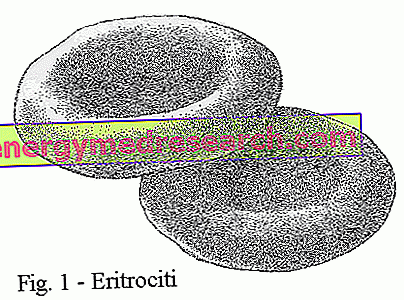Generality

Current therapy consists of the use of external hearing aids and the possibility of operating surgically. Both provide satisfactory results.
Anatomy of the ear
The ear is divided into three parts:
- External ear
- Middle ear
- Inner ear
The outer ear starts from the auricle and ends where the eardrum is located.
The middle ear is placed behind the eardrum and has three small bones: the hammer, the anvil and the stirrup. It communicates with the nose, through a duct called Eustachian trumpet . Therefore, air passes through the middle ear.
The inner ear is the area in which there are cochlea and semicircular canals . The cochlea is the organ of hearing; the semicircular canals, on the other hand, constitute the organ of balance.

THE THREE BONES OF THE MIDDLE EAR
The three little bones, hammer, anvil and stirrup, are so called because of their resemblance to the three tools used by the blacksmith during his craft work.
The hammer is the bone placed in contact with the eardrum. The bracket connects with the auger. Finally, the anvil connects the hammer and the bracket and interposes between them.
SOUND WAVES AND HEARING
How does the ear and the perception of sounds work?
Sound waves penetrate the outer ear and reach the eardrum. Struck by the sounds, the eardrum vibrates. This vibration is transmitted to the three ossicles, which set in motion. The hammer begins to move, then the anvil and, finally, the stirrup. In other words, the movement of a small bone determines the movement of the next one. It is the so-called ossicular chain .
From the bracket, the sound signal passes to the cochlea. The latter translates the sound into a nerve signal, which is directed to the brain for final identification.
What is otosclerosis
Otosclerosis is a pathology of the middle ear, which causes progressive hearing loss ( hypoacusis ). In fact, the bracket no longer correctly transmits the sound signal to the auger. Is this due to the growth of a bone mass around the stirrup, which "stiffens"? and "? œ locks"? the movements of the latter. In these cases, the bracket is called the sclerotic bracket, since the medical term, which defines similar processes, is sclerosis, ie hardening / stiffening.
Sometimes, the neo-formation of bone tissue can affect the junction between the bracket and the cochlea.
Otosclerosis usually affects both ears (bilateral otosclerosis). Unilateral otosclerosis is rare.
LOSS OF CAPACITY? HEARING
Otosclerosis can lead to different types of hearing loss. In fact, hearing loss can be:
- Conductive, when only the bracket is affected
- Mixed, sensorine-conductive, when both the bracket and the cochlea are affected
PATHOGENESIS: THE ORIGIN OF THE BONE MASS
The physiological process, which reciprocates the bone tissue, is altered: therefore, the formation and resorption mechanisms, carried out by osteoblasts and osteoclasts, respectively, are no longer balanced.
At this point, although prompted by the sound wave, the sclerotic bracket does not move and the perception of sounds is less.
Epidemiology
According to some estimates from the United Kingdom, otosclerosis affects about 1 or 2 people every 100 individuals. The Caucasian race is preferable, less the Asian and the African.
The age of onset is between 15 and 35 years; however, it can also occur in younger individuals.
It is found mainly in women.
Causes of otosclerosis
The precise cause of otosclerosis is unknown. There is, however, a well-founded hypothesis, which recognizes the reason for the disease in the interaction between two factors, genetic and environmental .
GENETIC FACTORS
It seems that several genes are involved, although more in-depth analysis is needed.
Furthermore, otosclerosis has a hereditary character. It has been observed that about 2 patients out of 3 have a family member with otosclerosis. Therefore, the family component is influential, but not strictly necessary.
ENVIRONMENTAL FACTORS
Researchers suspect different environmental factors. The main ones are:
- The measles virus
- The level of estrogen
- The fluorine content in the water drunk daily
The most studied and accredited environmental factor is the measles virus, since the new bone formations, which block the bracket, contain genetic material (traces of RNA), typical of this virus. Furthermore, it has been found that, since it is possible to be vaccinated against measles, the cases of otosclerosis have decreased.
However, it should be noted that, in some patients, no trace of viral RNA was found.
Studies on the level of estrogens and fluoride, on the other hand, need further study, because the data on these are controversial.
INTERACTION BETWEEN THE ENVIRONMENT AND GENETICS
Genetic predisposition and measles viral infection, if concomitant, promote the onset of otosclerosis.
As stated, this statement is supported by various scientific data, although it still has some question and exception points. There are, in fact, otosclerosis patients who have never contracted the measles virus or who do not have any family affection.
Symptoms, signs and complications
To learn more: Otosclerosis symptoms
The characteristic symptom of otosclerosis is hearing loss ( hypoacusis ), which can evolve in its most dramatic form: complete deafness .
The associated symptoms, of variable frequency, are instead:
- Tinnitus
- paracusia
- Vertigo and balance problems
- Nystagmus
Otosclerosis is also characterized by typical signs, which, in some cases, are found with appropriate acoustic tests. The main sign is the low volume of the tone of voice.
HEARING LOSS (IPOACUSIA)
Earlier otosclerosis leads to a slight hearing loss. Over the next few years, the acoustic deficit deteriorated gradually. The final stage, if the patient does not cure himself, is complete deafness.
A typical characteristic of otosclerosis hearing loss is the lack of perception of low and deep tones, such as the male voice.
Both ears are usually affected (bilateral). Sometimes, however, unilateral cases occur.
As we have seen, hearing loss is classified as conductive and mixed neurosensory .
The following table contains the main characteristics of the two types of acoustic deficits.
| Type of hearing loss | Organ of the affected ear | Effects |
| conductive | bracket | Acoustic deficiency, due to the immobility (or sclerosis) of the bracket |
| Mixed, sensorineural and conductive | Bracket and auger | In addition to the sclerotic bracket, nerve transmission from the ear to the brain is also compromised. The involvement of the auger also determines:
|
TINNITUS
Are tinnitus the so-called "? Œfischi"?, or "? œrums"?, in the ear. About 4 of 5 patients experience this symptom. The perception of these noises becomes more severe over the years: the progression of hearing loss is also followed by a worsening of tinnitus.
paracusia
Paracusis is another fairly common disorder. It consists of a better perception of sounds in noisy environments.
DISTURBANCES AND EQUILIBRIUM PROBLEMS
When the cochlea is also involved in the process of otosclerosis, dizziness and balance problems arise. Usually, the cochlea is affected in the advanced stages of the disease, so after several years. However, there are cases in which otosclerosis arises at the junction between the stirrup and the cochlea, causing vertigo immediately.
NYSTAGMUS
Nystagmus is the involuntary, rotatory-oscillatory movement of the eyeballs. It occurs rarely and only when the involvement of the cochlea is considerable.
SIGNS
The main sign of otosclerosis is the patient's tendency to speak with a low volume of voice. This is because the patient perceives his own voice as having very high and annoying tones.
Another sign of the disease is the so-called Schwartze sign . It occurs in 10% of the cases and consists in the presence of a blue-reddish spot at the junction between the bracket and the cochlea (more precisely, they are the so-called promontory and oval window ). The appearance of the stain is due to a vascular type phenomenon, called hyperemia, which draws blood to a certain point.
The search for one of these signs is a valid diagnostic tool.
COMPLICATIONS
The gradual hearing loss, if left untreated, leads to complete deafness . This is the main complication of otosclerosis.
CONTINUE: Otosclerosis - Diagnosis and Therapy »



